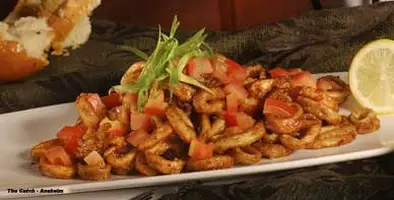By Robert Johnson
July/August 2009
Spanish literature and culture are rife with the themes of shadow and light (la sombra y la luz) which are used to show the contrasts between good and evil, rich and poor, and more dramatically,life and death. Appropriately, Spain is a country of contrasts, a country where the culture is steeped in tradition yet so modern that it sets many of the world’s trends – and Spanish cuisine has become a global phenomenon. Gone are the days when French cuisine reigns supreme. Now, thanks to the likes of Chef Ferran Adrii and his culinary wizardry, it is Spanish cuisine which is emulated, copied, studied, and sought after. One aspect of Spanish cuisine which has found its way on to many menus and epitomizes the notion of contrasts is tapas.
Tapas, if you didn’t already know, are small, appetizer-sized portions of food which are big on flavor.The true origins of tapas are somewhat obscure but there are some common (and plausible) theories which offer a palatable explanation. King Alfonso X, sometime in the 12th century, had just recovered from an illness where, during his recovery, he ate small bits of food accompanied with wine. Thinking the wine and food aided in his recovery the wise King declared that all taverns must serve wine with something to eat. At this time, it must be noted, not all tavern goers had the means to buy both food and drink and would invariably opt for just drink. Originally the wine of choice was a sweet sherry wine and insects were attracted to the dulcet aromas of the wine. In order to combat the pesky insects inventive tavern owners served salted meats or bread on top of the glass of wine. Tapar is a Spanish word which means “to cover” so tapa means “lid” or “cover”. Over time tavern patrons began to order wine with tapas and a sensation was born.
Today, tapas are found all throughout Europe, Canada and the U.S. The dishes have evolved from simple salted meats, breads and olives to fried squid, sauteed prawns with garlic sauce and scallops in a marinara sauce. Typically, in Spain, tapas are eaten between lunch and dinner in order to keep hunger pangs at bay.More importantly than for eating tapas bring people together. For some Spaniards tapas is a lifestyle and many have their favorite tapas bars which they frequent daily in order to meet with friends, catch up on news, and meet new friends. As the craze spread out to the rest of Europe and North America tapas are eaten in lieu of a full dinner.This encourages sharing among diners and everyone gets a few bites of a variety of plates.
What makes tapas so appealing is this ability to share or “graze” on a variety of dishes which provides a more satisfying experience for those who enjoy, as our Editor Teri Williams says, “three bites of everything”.Another appealing aspect of tapas is that diners do not eat one large meal but instead, if done properly, eat smaller portions at one sitting before continuing on with the next round, restaurant, or bar in hopes that this European style of grazing will help keep waistlines slim. Also, especially in the current economy, smaller plates mean smaller prices and the average check of a tapas dinner is not any higher than that of a full meal which helps keeps wallets trim as a result.
A few local restaurants that feature tapas on their menus have explained their concept of the small sensations as well as given us some insight into how their day to day operations and overall business have been impacted.
Sapphire Laguna, in Laguna Beach, has a unique take on tapas, which they call “Spice Plates”. Their inspiration comes from Chef Azmin Ghahreman, Managing Director of Sapphire Laguna Restaurant and Pantry, through his journey along the Old Spice Route in Southeast Asia, the stops he made at different ports along the route to purchase local spices, and the dishes he learned to prepare with the spices. Each plate features a different spice from around the world and each are under $10 a plate.
The tapas concept is taken to new heights at Flight Bistro & Social Lounge in Huntington Beach.Every aspect of their menu offers flights or a sampling of many different types of a particular item. For example a flight of cheese consists of a choice of three or five different cheeses. But cheese is not the only option; there are flights of meat, bruschetta, gelato, chocolate and even wine. The variety of flights they offer is in addition to their extensive Global Tapas Menu which, as the name suggests, serves a little something from various regions throughout the world all for about half the price of a regular entree.
Zimzala, on the second level of The Strand in downtown Huntington Beach, takes the Spanish concept of tapas and extends the flavors to include the entire coastal Mediterranean region. Zimzala, which means free-spirited person who finds peace with the sand between their toes, captures the Surf City mentality accurately while at the same time transports diners to such faraway places as Greece, Italy and Portugal. True to the spirit of tapas Zimzala’s “living room” lounge and shared plates create a environment conducive to communal dining, brings people closer together and to inspires conversation.
Since tapas are not the average protein, starch, and vegetable combination, one might expect there to be some challenges associated with serving them. This is not necessarily the case according to the restaurants we questioned. Food preparation is no issue to kitchen managers and prep cooks since most tapas are fried or as simple as olives and cheeses. However, the smaller price tag on the plates means that more of them need to be served per guest in order to make up food costs – usually 2-3 plates per client. Fortunately for restaurant managers, more plates do not necessarily require more staff to run them out to waiting diners as the attitude of most tapas patrons is relaxed and sociable which lends well to the fact that plates are served as they are made and not bought out all at once or in any particular order. Because of the variety involved with tapas it is necessary for restaurants to have a lot more product on hand than for standard full meals and this means that purchasing can be a challenge but savvy food managers cross utilize ingredients to eliminate this issue.
Another thing all the restaurants agreed upon is that the tapas sensation does have staying power and that current economic circumstances and global attitudes will only help perpetuate the trend. Grab a couple of friends, head out to your local tapas restaurant such as Sapphire, Flight or Zimzala and order a couple of plates a piece and savor the variety and the flavors of each – and don’t forget the wine!












